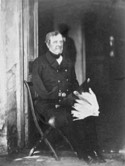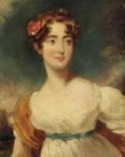Clement-Jones family - Person Sheet
Clement-Jones family - Person Sheet
Birth1788
Death1855
FatherHenry SOMERSET 5th Duke of Beaufort , 7031 (1744-1803)
MotherElizabeth BOSCAWEN , 3061 (1747-1828)
Spouses
Birth1792
Death1881
FatherWilliam WELLESLEY-POLE 3RD EARL OF MORNINGTON , 1035 (1763-1845)
MotherKatherine Elizabeth FORBES , 6428 (1761-1851)
Marriage1814
ChildrenRichard Henry Fitzroy , 7034 (1817-1884)
Notes for Fitzroy James Henry SOMERSET 1st Baron Raglan
Field Marshal FitzRoy James Henry Somerset, 1st Baron Raglan, GCB, PC (30 September 1788 – 29 June 1855), known before 1852 as Lord FitzRoy Somerset, was a British soldier.
Early life
He was the eighth and youngest son of Henry Somerset, 5th Duke of Beaufort,[1] by Elizabeth, daughter of Admiral the Hon. Edward Boscawen. His elder brother, General Lord Edward Somerset (1776–1842), distinguished himself as the leader of the Household Cavalry brigade at the Battle of Waterloo. Fitzroy Somerset was educated at Westminster School,[1] and was commissioned onto the 4th Light Dragoons in 1804.
Military career
In 1807 he was attached to the Hon. Sir Arthur Paget's embassy to Turkey, and the same year he was selected to serve on the staff of Sir Arthur Wellesley in the expedition to Copenhagen. In the following year he accompanied the same general in a like capacity to Portugal, and during the whole of the Peninsular War was at his right hand, first as aide-de-camp and then as military secretary.
He was wounded at the Battle of Buçaco, receiving five stab wounds to the left shoulder,and became brevet-major after Fuentes de Onoro.] He accompanied the stormers of the 52nd light infantry as a volunteer at Ciudad Rodrigo and specially distinguished himself at the storming of Badajoz, being the first to mount the breach, and afterwards securing one of the gates before the French could organise a fresh defence. During the short period of the Bourbon rule in 1814 and 1815, when Wellington became British Ambassador, Somerset was secretary to the British Ambassador at Paris. On the renewal of the war he again became aide-de-camp and military secretary to the Duke of Wellington. For his Peninsula services, Somerset was awarded the Army Gold Cross with five clasps and the Military General Service Medal with five clasps.
At Waterloo he was wounded in the right arm and had to undergo amputation, but he quickly learned to write with his left hand, and on the conclusion of the war resumed his duties as secretary to the embassy at Paris.[2] From 1818 to 1820, and again from 1826 to 1829, he sat in the British House of Commons as member for Truro.[2] In 1819 he was appointed secretary to the Duke of Wellington as master-general of the ordnance, and from 1827 till the death of the duke in 1852 was Military Secretary to him as commander-in-chief.[2] He was then appointed Master-General of the Ordnance,[2] a Privy Counsellor (16 October 1852) and was created Baron Raglan (20 October 1852).
Crimean War
In 1854 he was promoted to full General and appointed to the command of the British troops sent to the Crimea[2][3] in co-operation with a strong French army under Marshal St Arnaud and afterwards, up to May 1855, under Marshal Canrobert. Here his diplomatic experience stood him in good stead in dealing with the generals and admirals, British, French and Turkish, who were associated with him during the Crimean War.
Lord Raglan and his staff were at the time blamed by the press and the government for the hardships and sufferings of the British soldiers in the terrible Crimean winter before the Siege of Sevastopol, owing to shortages of food and clothing. During this unhealthy winter, the British contingent had 23,000 men unfit for duty due to ill health and only 9,000 fit for duty. It was afterwards suggested that the chief neglect rested with the home authorities, and the appalling logistical support from England certainly exacerbated an already poor situation.
Raglan was unaware of the growing rivalry between the Earl of Lucan and the Earl of Cardigan which would have tragic consequences in the infamous Charge of the Light Brigade.[2] At Balaklava he made several errors for which he received criticism, sending small British units against larger Russian contingents; which occasioned the complete destruction of the British units. One month later the British and French allied army gained a decisive victory at the Battle of Inkerman and he was promoted to the rank of Field Marshal.
During the trying winter of 1854–55 the anxieties of the siege began to seriously undermine his health [2] and although he found a friend and ardent supporter in his new French colleague, General Pélissier, the failure of the assault of 18 June 1855 affected him further, and very shortly afterwards, on June 29,[4]:p 302 he died due to complications brought on by a bout of dysentery. His body was brought home and interred at Badminton.[2]
[edit]Family
On 6 August 1814 he married Lady Emily Harriet Wellesley-Pole, daughter of the 3rd Earl of Mornington, the Duke of Wellington's niece. They had two sons:
The Hon. Arthur William FitzRoy Somerset (born 6 May 1816). He married (8 July 1845), as her first husband, Emile Marie Louise Wilhelmina de Baumbach, daughter of the Baron de Baumbach. A Major in the army, he was wounded at the Battle of Ferozeshah, 21 December 1845, and died of his wounds on 25 December 1845. As he left no children, the title passed on Lord Raglan's death to:
Richard Henry Fitzroy Somerset, 2nd Baron Raglan (1817–1884), the second son. He was in turn succeeded by his son George Fitzroy Henry Somerset, 3rd Baron Raglan.
The family seat is Cefntilla Court, Llandenny in Monmouthshire. A inscription over the porch dated 1858 reads:
This house with 238 acres of land was purchased by 1823 of the friends, admirers and comrades in arms of the late Field Marshal Lord Raglan GCB and presented by them to his son and his heirs for ever in a lasting memorial of affectionate regard and respect.
[edit]Memorials
The seaside town of Raglan in New Zealand was named after the First Lord in 1855.
The town of Raglan and the Fitzroy River in Victoria, Australia were also named after him.
There is a blue plaque outside his house in Stanhope Gate, London W1.
Early life
He was the eighth and youngest son of Henry Somerset, 5th Duke of Beaufort,[1] by Elizabeth, daughter of Admiral the Hon. Edward Boscawen. His elder brother, General Lord Edward Somerset (1776–1842), distinguished himself as the leader of the Household Cavalry brigade at the Battle of Waterloo. Fitzroy Somerset was educated at Westminster School,[1] and was commissioned onto the 4th Light Dragoons in 1804.
Military career
In 1807 he was attached to the Hon. Sir Arthur Paget's embassy to Turkey, and the same year he was selected to serve on the staff of Sir Arthur Wellesley in the expedition to Copenhagen. In the following year he accompanied the same general in a like capacity to Portugal, and during the whole of the Peninsular War was at his right hand, first as aide-de-camp and then as military secretary.
He was wounded at the Battle of Buçaco, receiving five stab wounds to the left shoulder,and became brevet-major after Fuentes de Onoro.] He accompanied the stormers of the 52nd light infantry as a volunteer at Ciudad Rodrigo and specially distinguished himself at the storming of Badajoz, being the first to mount the breach, and afterwards securing one of the gates before the French could organise a fresh defence. During the short period of the Bourbon rule in 1814 and 1815, when Wellington became British Ambassador, Somerset was secretary to the British Ambassador at Paris. On the renewal of the war he again became aide-de-camp and military secretary to the Duke of Wellington. For his Peninsula services, Somerset was awarded the Army Gold Cross with five clasps and the Military General Service Medal with five clasps.
At Waterloo he was wounded in the right arm and had to undergo amputation, but he quickly learned to write with his left hand, and on the conclusion of the war resumed his duties as secretary to the embassy at Paris.[2] From 1818 to 1820, and again from 1826 to 1829, he sat in the British House of Commons as member for Truro.[2] In 1819 he was appointed secretary to the Duke of Wellington as master-general of the ordnance, and from 1827 till the death of the duke in 1852 was Military Secretary to him as commander-in-chief.[2] He was then appointed Master-General of the Ordnance,[2] a Privy Counsellor (16 October 1852) and was created Baron Raglan (20 October 1852).
Crimean War
In 1854 he was promoted to full General and appointed to the command of the British troops sent to the Crimea[2][3] in co-operation with a strong French army under Marshal St Arnaud and afterwards, up to May 1855, under Marshal Canrobert. Here his diplomatic experience stood him in good stead in dealing with the generals and admirals, British, French and Turkish, who were associated with him during the Crimean War.
Lord Raglan and his staff were at the time blamed by the press and the government for the hardships and sufferings of the British soldiers in the terrible Crimean winter before the Siege of Sevastopol, owing to shortages of food and clothing. During this unhealthy winter, the British contingent had 23,000 men unfit for duty due to ill health and only 9,000 fit for duty. It was afterwards suggested that the chief neglect rested with the home authorities, and the appalling logistical support from England certainly exacerbated an already poor situation.
Raglan was unaware of the growing rivalry between the Earl of Lucan and the Earl of Cardigan which would have tragic consequences in the infamous Charge of the Light Brigade.[2] At Balaklava he made several errors for which he received criticism, sending small British units against larger Russian contingents; which occasioned the complete destruction of the British units. One month later the British and French allied army gained a decisive victory at the Battle of Inkerman and he was promoted to the rank of Field Marshal.
During the trying winter of 1854–55 the anxieties of the siege began to seriously undermine his health [2] and although he found a friend and ardent supporter in his new French colleague, General Pélissier, the failure of the assault of 18 June 1855 affected him further, and very shortly afterwards, on June 29,[4]:p 302 he died due to complications brought on by a bout of dysentery. His body was brought home and interred at Badminton.[2]
[edit]Family
On 6 August 1814 he married Lady Emily Harriet Wellesley-Pole, daughter of the 3rd Earl of Mornington, the Duke of Wellington's niece. They had two sons:
The Hon. Arthur William FitzRoy Somerset (born 6 May 1816). He married (8 July 1845), as her first husband, Emile Marie Louise Wilhelmina de Baumbach, daughter of the Baron de Baumbach. A Major in the army, he was wounded at the Battle of Ferozeshah, 21 December 1845, and died of his wounds on 25 December 1845. As he left no children, the title passed on Lord Raglan's death to:
Richard Henry Fitzroy Somerset, 2nd Baron Raglan (1817–1884), the second son. He was in turn succeeded by his son George Fitzroy Henry Somerset, 3rd Baron Raglan.
The family seat is Cefntilla Court, Llandenny in Monmouthshire. A inscription over the porch dated 1858 reads:
This house with 238 acres of land was purchased by 1823 of the friends, admirers and comrades in arms of the late Field Marshal Lord Raglan GCB and presented by them to his son and his heirs for ever in a lasting memorial of affectionate regard and respect.
[edit]Memorials
The seaside town of Raglan in New Zealand was named after the First Lord in 1855.
The town of Raglan and the Fitzroy River in Victoria, Australia were also named after him.
There is a blue plaque outside his house in Stanhope Gate, London W1.



